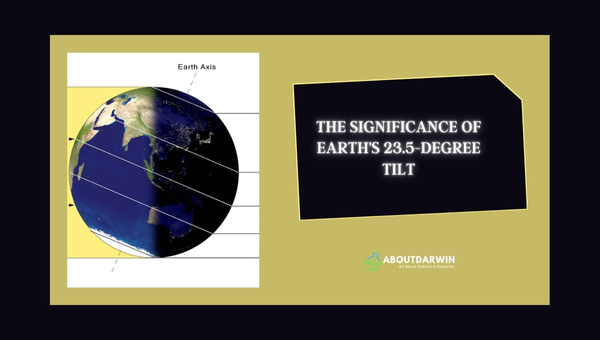Physical Address
304 North Cardinal St.
Dorchester Center, MA 02124
The tilt of the Earth’s axis, known as axial tilt or obliquity, plays a pivotal role in shaping our climate and seasons. Currently tilted at an angle of approximately 23.5 degrees, this inclination affects how sunlight is distributed across the planet throughout the year.
As we explore the fascinating implications of this tilt, we’ll uncover how it influences everything from seasonal changes to weather patterns.
What secrets does this axial tilt hold for our understanding of Earth’s climate? Let’s embark on a journey to unveil its significance.
Contents
Earth’s tilt is vital in how our planet experiences seasons, daylight hours, and climate variations. Let’s explore the key factors that make Earth’s 23.5° axial tilt so significant.

Seasons are a direct result of the Earth’s tilt on its axis. As our planet revolves around the Sun, the tilted axis causes different parts of the Earth to get varying amounts of sunlight throughout the year. For instance:
The Earth’s axial tilt also influences daylight hours. At different points in Earth’s orbit, other regions experience more or less daylight:
This phenomenon creates a stark contrast between seasons, such as the long daylight hours in the Arctic during summer and complete darkness during winter.
| Solstice | Hemisphere | Daylight Hours |
|---|---|---|
| Summer | Northern | Longer |
| Winter | Northern | Shorter |
| Summer | Southern | Shorter |
| Winter | Southern | Longer |
In part, climate variations can also be attributed to Earth’s tilt. Earth’s axial tilt causes a difference in solar radiation received by various latitudes, which in turn creates some notable climate patterns:
Earth’s 23.5° tilt is responsible for a diverse and ever-changing environment. Without the tip, the balanced mix of climates and seasonal variations we experience on our planet would radically differ. In addition, the tilt facilitates a wide range of ecosystems, supporting an array of distinctive flora and fauna.
Also Read: The Density of Earth: Insights into Our Earth’s Constituents
The Earth’s tilt at an angle of 23.5 degrees is a fascinating aspect of our planet that has shaped life as we know it. This axial tilt is a critical factor influencing seasonal changes, climate variations, and the overall dynamics of Earth’s environment.
Let’s explore the reasons behind this tilt in detail and understand its profound effects.
The tilt of the Earth’s axis is not random but a result of ancient cosmic events and processes. These origins can be outlined as follows:
Interestingly, Earth’s axial tilt isn’t fixed at exactly 23.5 degrees. This tilt undergoes slight variations over long periods due to gravitational influences from other celestial bodies. Here’s a closer look:
The tilt of the Earth’s axis is more than a cosmic coincidence; it is a driving force behind many aspects of life on our planet. To summarize its importance:
The Earth’s tilt at 23.5 degrees is a testament to the intricate interplay of cosmic forces that have shaped our world. Understanding this phenomenon deepens our appreciation of the balance and harmony that sustain life on Earth.
Earth’s 23.5° axial tilt plays a significant role in forming our planet’s climate and seasonal changes. In this section, I’ll guide you through how this tilt impacts various aspects of our environment, from temperature shifts to the distribution of sunlight.

The axial tilt allows different parts of Earth to receive varying amounts of sunlight throughout the year. During summer, a hemisphere is tilted towards the sun, leading to increased sunlight and higher temperatures.
In contrast, a hemisphere leaned away from the sun experiences winter, with less sunlight and lower temperatures.
Some essential effects of the Earth’s tilt on climate and seasons include:
To illustrate the impact of Earth’s tilt on climate and seasons more clearly, I’ve put together a table comparing temperature and daylight variations at the solstices and equinoxes, taking New York City as an example:
| Event | Average Temperature (°F) | Daylight Hours |
|---|---|---|
| Summer Solstice | 78 | 15h 5m |
| Winter Solstice | 38 | 9h 15m |
| Spring Equinox | 54 | 12h 8m |
| Autumn Equinox | 69 | 12h 8m |
It’s also worth mentioning that the Earth’s tilt slowly changes over time. This phenomenon is called axial precession, which occurs every 26,000 years. As the tilt varies between 22.1° and 24.5°, Earth’s climate goes through long-term changes, contributing to global temperature fluctuations and weather patterns.
So, in a nutshell, Earth’s 23.5° axial tilt significantly shapes the distribution of sunlight, temperature variations, and seasonal changes that contribute to our planet’s diverse climatic conditions.
Without this tilt, life on Earth would be drastically different, and understanding its impact helps us appreciate the unique environment that sustains our existence.
Also Read: 10 Asthenosphere Facts: Exploring the Earth’s Mysterious Layer
The Earth’s axis tilt plays a pivotal role in shaping our climate and seasons. This axial tilt, approximately 23.5 degrees, is responsible for the variation in sunlight received at different latitudes throughout the year.
As we experience the changing seasons, it’s fascinating to think about how this tilt influences not just weather patterns but also ecosystems and agriculture.
What other hidden wonders of our planet are waiting to be explored? The intricate dance of celestial mechanics continues to affect life on Earth in ways we are only beginning to understand.